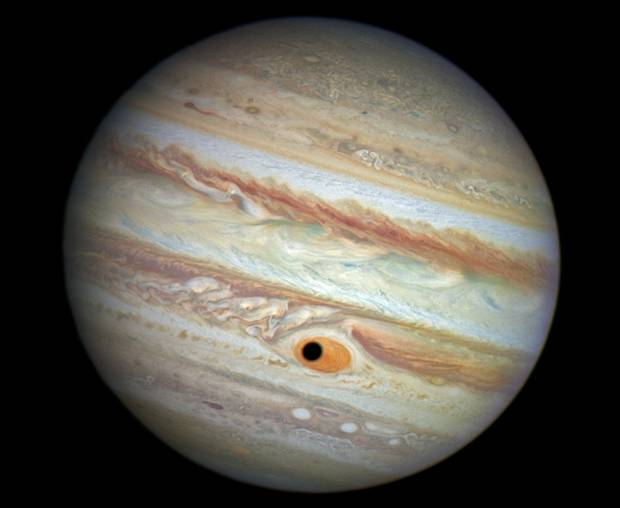NASA’s Hubble Space Telescope captured an exciting event they found a mysterious “black eye” on the surface of Jupiter, is the perfect Halloween prank, Hubble also able to capture the amazing giant eye sight. NASA noted that only giant eye is actually a shadow of Ganymede in Jupiter’s Great Red Spot storm. The image was captured by NASA’s Hubble Space Telescope as it tracked changes in Jupiter’s immense Great Red Spot storm. During exposure, shadows Ganymede The Great Red Spot across central. This time, let the Jupiter encounter grow a diameter 10,000 miles (about 16,000 kilometers) of the giant eye. Saturn hexagon storm, stir Saturn Arctic. Since first discovered 30 years ago, NASA has said: “At that moment, like Jupiter, like Cyclops staring at the Hubble Space Telescope.” Will start many unusual storms, the Great Red Spot on Jupiter is just one of them.
Now, planetary science research team at the University of Florida, the United States is to study Saturn’s hexagonal storms, as well as to determine its rotation period of Saturn. Saturn is the only one in the solar system does not determine the rotation period of the planet. The researchers said the change will not affect the hexagonal storm season and its jets, which are an integral part of the giant waves. The giant wave deeply rooted in Saturn’s atmosphere and wave formation in the Earth’s mid-latitudes similar.

Saturn will erupt unusual storm, one of the most compelling than stir Saturn hexagon Arctic storm. Since first discovered 30 years ago, this strange storm has been plagued by astronomers. Astronomers say the storm by revealing the operating mechanism of the hexagon, and in this process the rotation period of Saturn, they are expected to uncover the mystery of this strange storm. Astronomers noted that the mechanism of this giant storm similar to jet on Earth, which explains why it never gives the impression of movement. The width of the hexagonal storm reaches 20,000 miles (about 30,000 kilometers), is twice the diameter of the earth, the wind speed reached 200 miles per hour (about 320 kilometers per hour). On the other planets of the solar system, scientists have never found a similar storm in a regular geometric shape.
On Earth, the jet moves from west to east, is formed on the weather map we often see the low pressure area and the anticyclone area. Saturn is a giant gaseous planet, the volume is 10 times the Earth’s temperature is very low altitude clouds, no solid-state surface, the depth of the atmosphere and ocean fairly. The Planetary Science Research Group, said: “The jet hexagon growing movement in the vertical direction, allowing us to reveal the characteristics of Saturn’s atmosphere.”

